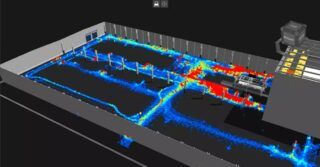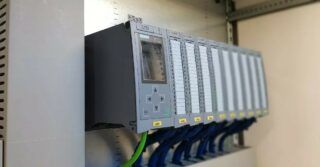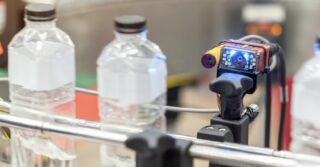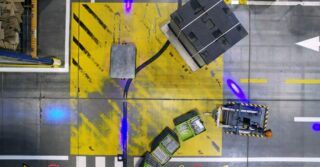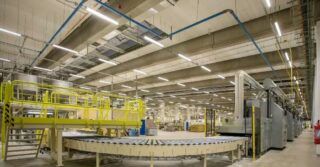C-parts account for up to 65-75% of the total purchase volume of most industrial companies. It is therefore worth exploring the potential for cost reduction in this area. RAWAG, a Rawicz-based manufacturer of equipment for public transport vehicles, has adopted such a strategy.
RAWAG, which has been part of the Bode Group since 2014, is a leading manufacturer of railcar equipment in Poland and Europe. The company’s products, for example doors or shelves, can be found every day in trains, buses and trams. More than 100 tonnes of aluminium sheets and profiles and as many as half a million fasteners are used in production every month.
The company, which has been in existence for half a century, is growing at a very dynamic pace, consistently applying the principles of lean management. The constant search for new areas of optimisation has also extended to fasteners. RAWAG engaged Bossard Poland, a local branch of the global industry leader in industrial fasteners and intelligent production logistics systems for C-parts, to collaborate.
The starting point for the collaboration was the TCO (Total Cost of Ownership) model for C-parts, on which Bossard’s proprietary 15/85 rule, also known as the iceberg model, is based.
What is the 15/85 rule?
The TCO model that Bossard uses for fasteners is based on a tool developed by the Institute of Technology Management at the University of St Gallen. It shows that the total cost of managing this range has the structure of a symbolic iceberg.
Only 15% is the unit price of the product in question, the rest, or 85%, is the entire ecosystem including, but not limited to: design and development, procurement, quality control, inventory maintenance, assembly, logistics, etc. The range of processes involved in handling this assortment group shows great potential for optimisation, often not yet discovered in industrial companies.
The 15/85 rule, with its holistic approach, fits in with the sustainability strategy. It makes it possible not only to reduce costs, but also to streamline processes, including logistics and purchasing
Assortment analysis and optimisation
When starting its collaboration with Rawag, Bossard analysed the products, assembly lines and assortment of more than 2,000 fasteners in detail, identifying as many as 700 possibilities for optimising the fasteners. Their implementation will have a significant impact not only on the reduction of the assortment (by as much as 15%), but also on the quality, fluidity and costs of the assembly processes.
Rawag attaches particular importance to managing the factory in accordance with the lean philosophy. SMED, Kaizen or 5S are just some of the lean tools that the 600-strong workforce uses in their daily work. Lean Management Manager Albert Łoza gained his experience working for seven years in Japan at the world’s largest automotive company, the cradle of the lean philosophy. Every area of the production process is important, he says, and it is worth looking at even such seemingly minor components as screws or nuts.
Smart logistics for C-parts
Rawag is an example of a company that has grown tremendously in a fairly short period of time through actions in line with the lean philosophy, says Albert Łoza. – Focusing on eliminating waste in the production process, the topic of fastener management cannot be overlooked. We are about to implement the SmartBin system, which will improve parts availability and optimise the ordering process, which will now proceed automatically. SmartBin will also allow better management of C-parts in terms of stock control, changes in demand and obsolete items.
Bossard SmartBin is a system based on the traditional kanban method, but fully automated. It is part of Bossard’s comprehensive logistics offering known as Smart Factory Logistics. This ecosystem consists of containers equipped with weight sensors connected wirelessly to the dedicated Bossard ARIMS IT platform, which completes and processes the data coming in from production.
The principle is simple. The weight sensors in the containers identify a predefined critical stock level, immediately sending the demand to the system. The system completes the demands, combines them into orders and passes them on to the supplier. This is usually Bossard, but this is not a prerequisite, as the company also offers a supplier consolidation service, which means that other C-parts in the factory can also be managed by the Bossard SmartBin system.

Why is it worth automating?
The advantages of using such a solution are many. First and foremost, it saves the purchasing department time, as the ordering of missing materials takes place virtually unattended. With a properly configured system, processes become much more transparent and production predictability much higher. Downtime, which always has its more or less severe consequences, can thus be avoided.
The automation of the fastener ordering process also saves space in the warehouse. This is because there is no longer a need to stockpile excessively large quantities, as the parts required are ordered and delivered on the fly. Their distribution in special racks close to the assembly line/station translates into better availability and savings in crew time.
Thanks to the ARIMS mobile application, production managers have real-time access to stock levels, order lists, delivery times, etc. from any location inside or outside the factory. On the basis of the data obtained from the system, it is also possible to plan future production more effectively.
Anticipated benefits of implementing Bossard solutions at RAWAG
- Reduction in the C-parts range by 15%;
- Nearly 700 fastener optimisations;
- 2-fold reduction in warehouse flows;
- Improved internal logistics;
- Reduced inventory;
- Smoother delivery management;
- Improved invoice and payment control;
- Higher productivity;
- Noticeable annual savings.


